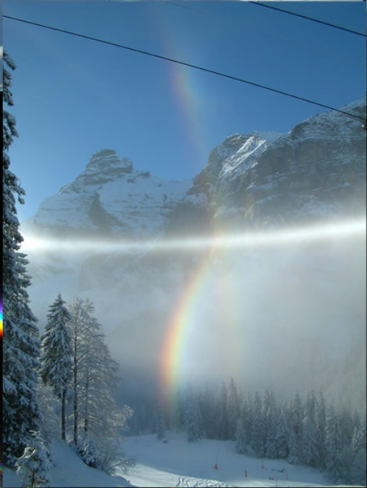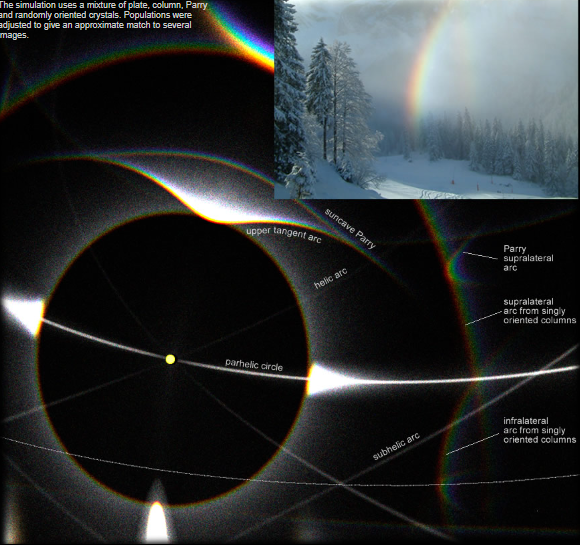Rare Mountain Halos
Rare Mountain Halos: A Captivating Atmospheric Phenomenon
Rare mountain halos are a mesmerizing atmospheric optical phenomenon that occurs in certain mountainous regions. These unique displays of light and color are caused by the interaction of sunlight with ice crystals in the air, creating a spectacle that is both captivating and rare. In this article, we will explore the intricacies of mountain halos, shedding light on their formation, characteristics, and the elements that make them so extraordinary.
The Parhelic Circle: A Solid White Bar Across the Air
One of the distinguishing features of rare mountain halos is the presence of a parhelic circle, which appears as a solid white bar cutting across the sky. This phenomenon occurs when the low sun is positioned to the left, and it is often mistaken for a 46° halo. However, the parhelic circle can be clearly differentiated from the circular halo by the cusp formed as they intersect. The parhelic circle is a result of singly oriented column crystals, adding a unique touch to the overall display.
Supralateral and Infralateral Arcs: Adding Splashes of Color
The colored halos observed in rare mountain halos are known as infralateral and supralateral arcs. These arcs are created by the interaction of sunlight with the column crystals in the atmosphere. The infralateral arc appears below the parhelic circle, while the supralateral arc can be seen above it. These arcs contribute to the enchanting beauty of mountain halos and enhance their visual appeal.
The Subhelic Arc: A Faint Arc Sloping Upwards
In certain instances, a faint subhelic arc can be observed in rare mountain halos. This arc originates from the sun and slopes upwards until it intersects with the parhelic circle. Its presence is the result of a complex ray path, involving multiple reflections inside column crystals. The subhelic arc adds an element of mystique to the overall display, creating a truly captivating sight.
Parry Supralateral Arc: A Rare Sight
A noteworthy addition to the rare mountain halos is the Parry supralateral arc. Originally observed in Antarctica, this arc has been captured in one of the earliest images of its occurrence elsewhere. The Parry supralateral arc is projected against the blue sky and touches the supralateral arc, creating a visually stunning combination. This discovery expands our understanding of these optical phenomena and adds to their allure.
Helic Arcs: Glints of Sun Reflection
Another intriguing feature of rare mountain halos is the presence of helic arcs. These arcs are formed by sun reflections off the side faces of the Parry columns. They appear as glints across the sky, adding a subtle shimmer to the overall display. The helic arcs contribute to the intricate nature of mountain halos, showcasing the complexity of light interaction with ice crystals in the atmosphere.
Formation and Possible Downwind Influence
The formation of rare mountain halos is a fascinating process that involves various types of ice crystals, including plates, columns, Parry crystals, and randomly oriented crystals. The exact mechanisms behind their formation are still being studied, but it is believed that they are possibly formed downwind of ski-slope snow machines. Further research is needed to fully understand the factors that contribute to the creation of these captivating optical displays.
Unveiling the Secrets: Ray Tracing Simulations
To gain further insights into the intricacies of rare mountain halos, scientists employ ray tracing simulations. These simulations utilize a combination of different crystal populations, including plates, columns, Parry crystals, and randomly oriented crystals. By adjusting the populations to match observed images, researchers can approximate the formation and characteristics of these rare optical phenomena. Ray tracing simulations help uncover the secrets behind the mesmerizing beauty of mountain halos, providing valuable information for further study and analysis.
In conclusion, rare mountain halos are a truly extraordinary atmospheric optical phenomenon that showcases the complexity and beauty of light interacting with ice crystals in the air. The presence of the parhelic circle, infralateral and supralateral arcs, subhelic arc, Parry supralateral arc, and helic arcs creates a captivating display that enchants viewers. The formation of these halos and their possible association with ski-slope snow machines add to their allure and warrant further investigation. Through ray tracing simulations, scientists continue to unravel the mysteries surrounding rare mountain halos, bringing us closer to understanding the intricate workings of our atmosphere and the captivating phenomena it can produce.

Mountain Halos, Switzerland imaged by Alistair Adams 21st December '04. Images ©Alistair Adams, shown with permission.
In this very exceptional and rare diamond dust. display the parhelic circle crosses the air as a solid white bar. The low sun is to the left and the coloured halos are infralateral and supralateral arcs from singly oriented column crystals. Often mistaken for a 46� halo, the cusp as they intersect at the parhelic circle distinguishes them clearly from the more rare circular halo.
The scene is repeated in another image at right which this time shows halos of rather greater rarity. The accompanying HaloSim.. ray tracing simulation identifies them. Sloping upwards from the sun to eventually cross the parhelic circle is a faint subhelic arc, the product of a tortuous ray path with multiple reflections passage inside column crystals.
Projected against the blue sky and touching the supralateral arc is a Parry supralateral arc. At first seen only in Antarctica, this is one of the earliest images showing it elsewhere. Another arc from the improbably oriented Parry crystals is the helic arc visible faintly across the sky. Helic arcs are the glints from sun reflections off the side faces of the Parry columns.
. Possibly but not with certainty formed downwind of ski-slope snow machines.
.. The simulation uses a mixture of plate, column, Parry and randomly oriented crystals. Populations were adjusted to give an approximate match to several images.


Note: this article has been automatically converted from the old site and may not appear as intended. You can find the original article here.
Reference Atmospheric Optics
If you use any of the definitions, information, or data presented on Atmospheric Optics, please copy the link or reference below to properly credit us as the reference source. Thank you!
-
<a href="https://atoptics.co.uk/blog/rare-mountain-halos/">Rare Mountain Halos</a>
-
"Rare Mountain Halos". Atmospheric Optics. Accessed on November 24, 2024. https://atoptics.co.uk/blog/rare-mountain-halos/.
-
"Rare Mountain Halos". Atmospheric Optics, https://atoptics.co.uk/blog/rare-mountain-halos/. Accessed 24 November, 2024
-
Rare Mountain Halos. Atmospheric Optics. Retrieved from https://atoptics.co.uk/blog/rare-mountain-halos/.